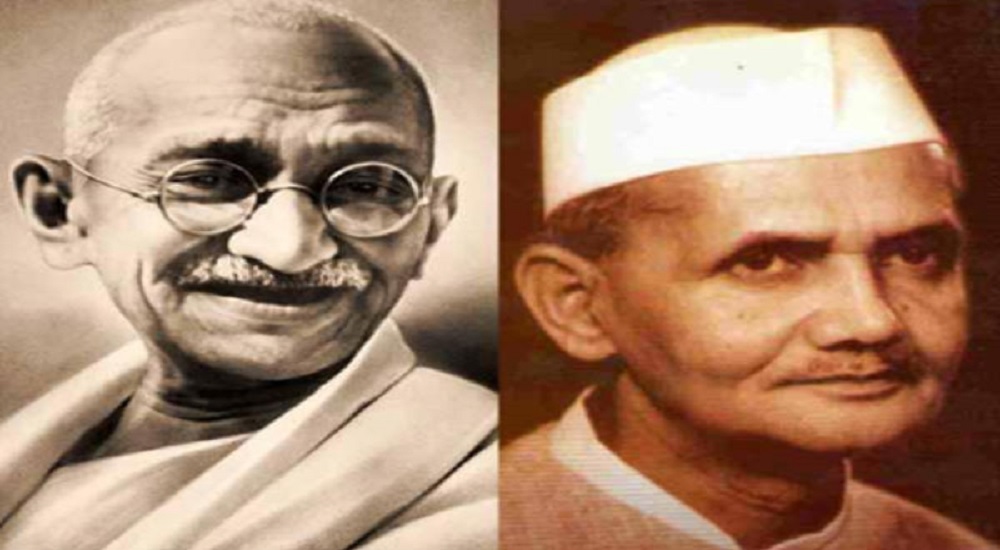
2nd Oct : A Day To Learn from Two Great Personalities
Second of October calls for a red-letter day for Indians. This was the day when two great personalities were born. One was Mahatma Gandhi and other was Lal Bahadur Shastri. Both led the nation in difficult times. Both were great leaders and great personalities. Apart from being a national holiday, this day makes us learn a lot of things.
Mahatma Gandhi
Mohan Das Karamchand Gandhi was born in Porbandar in Modern Gujarat state of India on 2nd Oct 1869. His father Karamchand Uttamchand Gandhi served as Diwan to Porbandar state. His mother Putlibai was a home maker. At age 9, Gandhi entered school in Rajkot. At age 11, he joined the High School in Rajkot. He was a shy and tongue-tied student, with no interest in games; his only companions were books and school lessons. At the age of 13, he got married to Kasturbai Makhanji Kapadia alias Kasturba. On 4 September, he sailed from Bombay to London to attend University College, London. Gandhi, at age 22, was called to the bar in June 1891 and then left London for India. His attempts at establishing a law practice in Bombay failed because he was psychologically unable to cross-examine witnesses. In April 1893, Gandhi aged 23, set sail for South Africa. He spent 21 years in South Africa, where he developed his political views, ethics and practises. This phase of Gandhi saw the start of political and social engagement.
At the request of Gopal Krishna Gokhale, Gandhi returned to India in 1915. He brought an international reputation as a leading Indian nationalist, theorist and community organiser. This role and quality worked to organise the Indian struggle for independence. Prior to this there were many struggles for independence. But that struggle, led by Gandhi, was an organised struggle for Indian independence.
Leadership Lesions From Gandhi
Innovation:
What is worth mentioning is the innovation. His way of opposing the rule was different. There was no direct armed confrontation, unlike 1857. Rather this was more like standing in one’s feet, economic improvement, social upliftment and right education. Age old methods of fight were discarded and exerting pressure tactics with mass involvement became new norm of struggle.
Like this, in an organisation, regular innovation is required. Slowly old way of working, to be renewed and replaced. This brings fresh ideas and improves product and services of a company.
Involvement:
He worked for lower caste and their upliftment. Each section of society has its own importance. No section is unwanted. The country or a society lives due to symbiosis of various sections doing various work. This further strengthened the freedom movement.
Likewise, in a company, every department has their own role. No department is unwanted or less important. No department should be left unattended. This strengthens the structure of organisation.
Teamwork:
Gandhiji encouraged the khadi movement where rural people worked, in order to make the nation less dependent on British textile. This brought many people together and started spreading teamwork across.
This type of teamwork is essential in all phases of life. Bigger enterprises spend a lot of time and money for teamwork. This is an essential criterion for team success or success of an organisation.
Unification of goal:
Organisation of freedom movement was an achievement. All regional political parties or syndicates were drawn under one umbrella and their motive and ambition become one. This was not there previously.
This is a vital step. In an organisation goal of a team member should be in sync with the goal of the organisation. Unless this happens, the organisation is not going to move. Even in professional field, a project becomes successful, when entire team works for a common goal. The success or failure of project depends on work each member of team do.
Above three qualities are required for growth and development of an organisation.
Lal Bahadur Shastri
Lal Bahadur Shastri was born to Sharada Prasad Srivastava and Ramdulari Devi in Mughalsarai on 2 October 1904. He studied in East Central Railway Inter college and Harish Chandra High School. Inspired by the Mahatma’s call for students to withdraw from government, he exited Harish Chandra High School the next day and joined the local branch of the Congress Party. He graduated with a first-class degree in philosophy and ethics from the Kashi Vidyapith in 1925. In 1928 Shastriji became an active and mature member of the Indian National Congress. Following India’s independence, Shastriji was appointed Parliamentary Secretary in Uttar Pradesh. He became the Minister of Police and Transport under Govind Ballabh Pant’s Chief Ministership on 15 August 1947. In 1951, Shastriji was made the General Secretary of the All-India Congress Committee with Jawaharlal Nehru as the Prime Minister. Shastriji was made Minister of Railways and Transport in First Cabinet of Republic of India on 13 May 1952. He served as the Minister of Commerce and Industry in 1959 and Minister of Home Affairs in 1961. Jawaharlal Nehru died in office on 27 May 1964. Then Congress Party president K. Kamaraj was instrumental in making Shastriji Prime Minister on 9 June. This tenure of Prime Ministership saw some of the toughest challenges.
Leadership Lessons From Lal Bahadur Shastri
Women empowerment:
As the Transport Minister, he was the first to appoint women conductors.
An organisation or society will grow only when both men and women work hand in hand. In an order to do well, both men and women must be given similar opportunities. This only makes the way for growth of organisation but also paves the way for some of the finest ideas.
Force – Now always a good idea
As the minister in charge of the Police Department, he ordered that police use water jets, instead of lathis to disperse unruly crowds. His tenure as police minister (As Home Minister was called prior to 1950) saw successful curbing of communal riots in 1947.
Force is not always a great option to exercise. At times, this increases the friction between the parties. Soft force with right counselling is the best way to deal with the situation. Similarly in an organisation, force must not be used to make others, obey instructions. At times, disciplinary actions have bad effects.
A clarity message from leader
Lal Bahadur Shastri’s tenure witnessed the Madras anti-Hindi agitation of 1965. The government of India had for a long time tried to establish Hindi as the sole national language of India. This was resisted by the non-Hindi speaking states particularly Madras State. To calm the situation, Shastri gave assurances that English would continue to be used as the official language as long the non-Hindi speaking states wanted. The riots subsided after Shastri’s assurance, as did the student agitation.
Many a times, in an organisation, general people get annoyed because of various reasons and situation get tense. In those situations, a message of clarity from the topmost leadership, makes a difference.
Shastri Vrat – Dealing With crisis & leaders showing the path
India faced chronic food shortage during that time. Shastriji urged people to voluntarily give up one meal so that the food saved could be distributed to the affected populace. He ensured that he first implemented the system in his own family before appealing to the country. The response to his appeal was overwhelming. Even restaurants and eateries downed the shutters on Monday evenings. Many parts of the country observed the “Shastri Vrat”. He motivated the country to maximize the cultivation of food grains, by ploughing the lawn himself, at his official residence in New Delhi. Shastri also promoted the Green Revolution in India in 1965.
Crisis comes in every phase of life. A real leader deals with this in proper way with right strategy. Leading from front is the real option. A leader should do the thing first. This motivates his or her team to do it with true zeal.
Dealing with threats – A Show of leadership
Laying claim to half the Kutch peninsula, the Pakistani army skirmished with Indian forces in August 1965. On 1 August 1965, major incursions of militants and Pakistani soldiers began, hoping not only to break down the government but incite a sympathetic revolt. The revolt did not happen, and India sent its forces. Addressing the nation on 13th August 1965 Shastriji gave strong message by saying, “Force will be met with force”. Indian forces captured the key post at Haji Pir, in Kashmir, and brought the Pakistani city of Lahore under artillery and mortar fire. It was the same time, when food scarcity too was a concern for the country. In other words, he dealt with two crisis together.
Crisis comes without any notice. A leader knows how to handle that and organises his or her team. His planning and decision making are of utmost importance. Decision making of leaders can make or break the situation. Important is, how effectively he can manage the crisis.
The learning from them are endless.




More Blogs
UPI And Pay Now Integration
India Australia Trade Agreement – An Analysis !
5G & Impact On Business